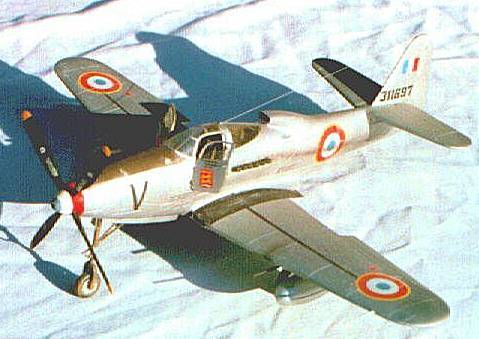
Hi Tech 1/48 BELL P-63C KINGCOBRA
Price: MSRP $34.95
Media: limited-run injection-molded plastic with cast-resin cockpit interior
Decals: Aeromaster sheet - 1 French Air Force P-63C in Indochina, 1949
Accuracy: B+
Overall: C-
Review and Photo by: Thomas McKelvey Cleaver (THE AERONUT)
Date of Review: 5 January 1998

The P-63 Kingcobra was developed from the P-39 Airacobra, and began life as the P-39E, a version with a laminar-flow wing. The aircraft, while outperforming its predecessor, did not offer sufficient performance compared with the Mustang to see it adopted in front-line service by the U.S.A.A.F., though some 200 P-63A and P-63C models were converted to the RP-63G "flying target" to train aerial gunners firing frangible bullets at the armored airplane. The Russians, who loved the P-39, couldn't get enough of the P-63, and the overwhelming majority of these aircraft went to the Soviet Union under Lend-Lease. Approximately 100 also went to the French Air Force during the war and were retained in service until 1950.
I was interested when this model appeared, as the P-63 is a good-looking airplane, and historically-significant. I have used Hi-Tech conversion parts for a P-51B from the A-M P-51A (obviously prior to Tamiya's release of the B) and for a conversion of Mauve P-40Ms to P-40F and P-40E. I looked forward to doing it. Given that there was to be only a 1,000-kit release, it seemed like something different and interesting.
The Chinese have an old curse, "may you live in interesting times," and that is pretty much what happened to me with this kit. Now that I see there is a further release of this thing, I believe you should have the benefit of my having lived through it.
For starters, the wings are in upper and lower halves, molded solid, and you must take off approximately 1/32 of the entire inner surface to get the wings thin enough to fit the rest of the model and look halfway realistic. The same is true of the lower center section. In fact, almost every part of this model except the horizontal stablilizers needs thinning before construction. And then one nearly needs to coat every joint in putty to get something that looks halfway like an airplane.
To top it off, the vacuform canopy is undersized, and you only get one. I had to take separate plastic and hand form it to make the rear section of the canopy, use plastic card for the section over the turnover/armor glass - which also had to be rebuilt - and had to open both doors to keep the casual observer from seeing just how bad the misfit of the canopy was. The one other solution to this would be to make an RP-63G, using a solid rear canopy section, which would be easier to make. The one saving grace is that the cast-resin cockpit was good, so there is something to look at inside those doors.
The end result does look like a Kingcobra. The Aeromaster decals are up to their usual quality, and create a P-63C used in 1949 in the First Indochina War. I used 75-gallon drop tanks from the spares box to add to the overall look, and made certain to do the natural metal finish as dull as it would be in a tropic climate.
This is one of those models, like the HiPM SB2U Vindicator and Classic Airframes SBC-4 Helldiver that look good in the end, but were more work than I would do again to accomplish. The only current alternative to this kit, the P-63C released by MPM, is even worse according to reviews I have read. Given that HiPM has gone from awful (the SB2U) to bad (the AR-196) to pretty darned good (the He-100D), perhaps they will still be on that upward curve when they release their P-63A later this year. I certainly hope so! You have been warned.